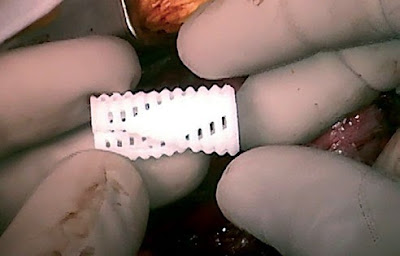Recently, a 4D biomaterial
 |
| 3D-printed tracheobronchial splint used in one of the baby boys [Image courtesy: Morrison et al., Science Translational Medicine (2015)] |
a medical implant designed to change shape over time allowed three children to keep breathing, in effect, saving their lives. The implants were made using a 3D printer, which can create items from a wide variety of materials such as plastic, ceramic,
glass, metal and even living cells.
Scientists have now begun developing techniques to try out 4D printing, which involves 3D printing items that are designed to shape-shift after being printed. The three infant boys who were implanted with the new device were suffering from tracheobronchomalacia, a disease that causes the windpipe to regularly collapse, preventing normal breathing. Researchers used CT scans of the boys to develop 3D-printed airway splints whose
Scientists have now begun developing techniques to try out 4D printing, which involves 3D printing items that are designed to shape-shift after being printed. The three infant boys who were implanted with the new device were suffering from tracheobronchomalacia, a disease that causes the windpipe to regularly collapse, preventing normal breathing. Researchers used CT scans of the boys to develop 3D-printed airway splints whose
length, diameter, thickness and other factors were customised for each baby. The splints, made of polycaprolactone that dissolves in the body over time, were implanted into the babies and sewn around their windpipes; devices kept surrounding tissue from pushing in and sealing the airways shut. These hollow and porous splints were designed to spread open as the children grew.
Hyperlens that helps view tiny objects
According to scientists, a slinky hyperlens can help us see tiny objects that elude even the most powerful optical systems. The metamaterial hyperlens may someday even help detect some of the most lethal forms of cancer. It is also expected to lead to advancements in nano-electronic manufacturing and boost a scientist’s ability to examine single molecules. Conventional optical systems, such as microscopes and cameras, are limited by diffraction, a phenomena in which light bends as it passes around an edge or through a slit. Metamaterial hyperlenses overcome the diffraction limit by transforming decaying evanescent waves into propagating waves. Once converted, the former decaying waves, which were commonly lost in conventional imaging, can be collected and transmitted using standard optical components.
Lift your house in case of an earthquake
The future vision for Greg Henderson of Arx Pax, makers of Hendo Hoverboard, is deploying the
technology Hendo Hoverboard uses on a large-scale to protect houses during a massive earthquake.
Arx Pax has in place systems that employ water or gas to lift homes. It, however, aims to eliminate the structural movement entirely and use magnets instead. Their goal is to have the building’s landing gear react and activate the hover engines as soon as an earthquake strikes. In order to lift a three-story home for about 90 seconds, which is the length of an average earthquake, the power required can be supplied using five car batteries.
technology Hendo Hoverboard uses on a large-scale to protect houses during a massive earthquake.
Arx Pax has in place systems that employ water or gas to lift homes. It, however, aims to eliminate the structural movement entirely and use magnets instead. Their goal is to have the building’s landing gear react and activate the hover engines as soon as an earthquake strikes. In order to lift a three-story home for about 90 seconds, which is the length of an average earthquake, the power required can be supplied using five car batteries.
Arx Pax would require installation of the hover engines and an earthquake-proof base. Computers would automatically turn on the engines as soon as these sense an earthquake. These will also have ShakingAlert software system that senses earthquakes, integrated in the system, which has successfully detected earthquakes in the past.










0 comments:
Post a Comment